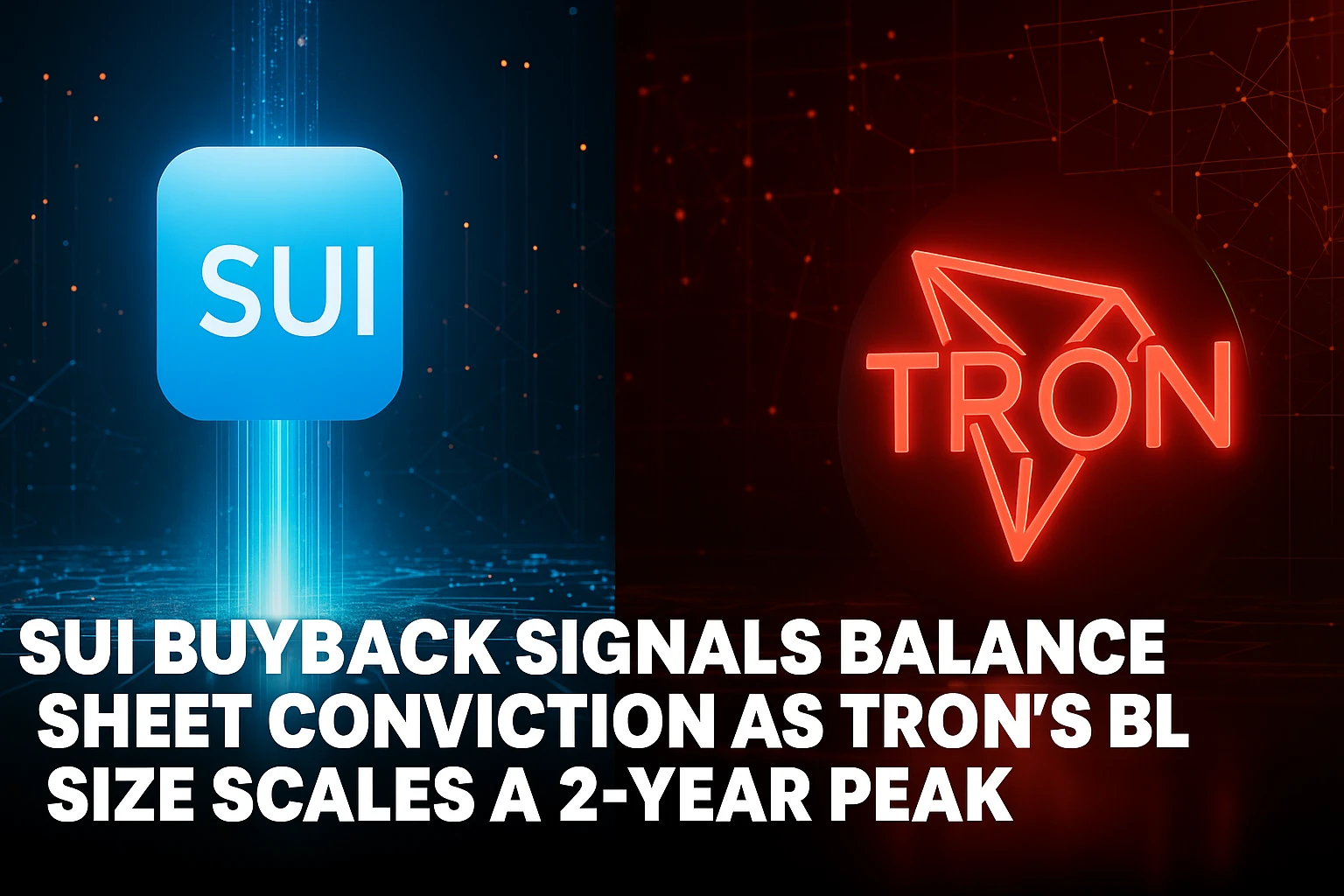Sui Buyback Signals Balance Sheet Conviction as Tron’s Block Size Scales a 2-Year Peak

Sui and Tron delivered two distinct but complementary signals this week. On one side, Sui Group authorized a $50 million stock repurchase after completing an earlier two-million-dollar tranche with clear price and volume details.
- What Does the Sui Authorization Speak About Capital and Timing
- Why Tron Block Size Trend Matters for Throughput
- The Tweets Shaping Real-Time Attention
- Verifiable Items Investors Can Track
- Reading The Sui Story As A Balance Sheet Case Study
- Reading Tron Story as a Throughput Case Study
- A Blended Read on Capital and Throughput
- Risks And Monitoring Checklist
- Conclusion
- Frequently Asked Questions About Sui Buyback And Tron Activity
- How large is the Sui Group buyback authorization?
- What did the completed Sui repurchase include?
- What on-chain metric is rising on Tron?
- Do the tweets cited change the facts?
- How does Delegated Proof of Stake relate to these signals?
- What should investors watch next on Sui?
- What should investors watch next on Tron?
- Glossary of Key Terms
On the other hand, Tron’s average block size reached its highest 100-day reading since July 2023, a metric that points to persistent on-chain demand rather than a single-day spike.
Taken together, the developments map capital and throughput in real-time for two networks that are often evaluated through the lens of Delegated Proof of Stake (DPoS).
The operating question for investors is how these signals translate into the durability of activity and balance sheet support without leaning on speculative narratives.
ALSO READ: Ark Invest Diversifies Exposure: Sells Tempus AI; Buys Amazon, Figma, and Bullish Shares
What Does the Sui Authorization Speak About Capital and Timing
The market has seen buyback headlines before, but the Sui Group disclosure offers rare specificity. The company reported that between September 10 and September 12, it repurchased more than 318,000 shares at an average price of $4.30, completing a $2 million program.
Immediately following that, the board authorized up to 50 million dollars for additional repurchases through open market purchases, privately negotiated deals, or other permitted methods. The combination of disclosed execution and fresh authorization creates a trackable path that investors can monitor across future updates.
The authorization sits alongside a treasury update. Coverage noted that the firm lifted reserves by acquiring 20 million SUI on September 3, bringing total holdings to about 101.79 million SUI and citing a treasury program aligned with Galaxy Digital.
Whether one treats these figures as valuation inputs or governance context, they anchor the capital story in numbers rather than adjectives. For equity holders, a buyback can support net asset value per share while tightening the float. For crypto observers, a large token treasury can intersect with staking and validator participation that is common in Delegated Proof of Stake systems.
ALSO READ: TRON Shifts to Enterprise iOS Rail as ARK Invest Prunes ETFs and Repositions Holdings
Why Tron Block Size Trend Matters for Throughput
On a chain, directional trends matter more than one-day records. Tron’s average block size has been climbing, with the 100-day simple moving average hitting its highest point since July 2023.
Reporting attributes the rise to sustained transfers of USDT, broader consumer usage, and an active DeFi base. A rising average block size is best read as more data packed into each block, which in turn suggests more transactions or richer payloads. The key qualifier is performance. Growth that is not accompanied by congestion or elevated failure rates tends to indicate tested infrastructure rather than stress.
The market color around that metric has been unusually explicit. A widely cited on-chain analyst summarized the move with a simple line that the 100-day average has reached its highest level since mid-2023 and singled out stablecoins and DeFi as drivers. The analyst post is useful as a pointer, but the durable takeaway is the metric itself and its trajectory.
ALSO READ: Cardano Boss Puts $200M Into Healthcare Amid Top Show By TRON and XDC Network
The Tweets Shaping Real-Time Attention
Two posts captured the week’s narrative and are included here strictly as contemporaneous color.
Lennaert Snyder on SUI levels and momentum
https://twitter.com/LennaertSnyder/status/1966559713413267553 (X (formerly Twitter))
CryptoOnchain on Tron’s average block size trend
https://twitter.com/CryptoOnchain/status/1967209118780796929 (X (formerly Twitter))
Verifiable Items Investors Can Track
| Item | Date or Range | Figure or Statement |
| Sui Group buyback authorization | September 15, 2025 | Up to 50,000,000 dollars authorized for common stock repurchases |
| Completed repurchase execution | September 10 to 12, 2025 | More than 318,000 shares were bought at $4.30 average price, totaling about $2,000,000 |
| SUI reserves noted in coverage | As of early September 2025 | Total holdings reported near 101.79 million SUI after a 20 million SUI acquisition on September 3 |
| Tron on chain usage proxy | September 15, 2025, report | Average block size 100-day moving average at the highest level since July 2023 |
Reading The Sui Story As A Balance Sheet Case Study
Share repurchases are linear to explain and complex to execute. The Sui case gives clarity on both axes. First, the company completed a small but measurable two-million-dollar buyback with transparent pricing and timing.
Second, it set a much larger ceiling for future repurchases. If market conditions remain favorable and execution continues, the impact will be twofold. Per share exposure to the underlying asset base would rise as shares are retired, and the signal of confidence could help narrow any perceived discount to net assets.
Coverage also highlighted that the firm’s token reserves increased and referenced a treasury program with a recognized institutional partner, which aligns with a view that balance sheet strength and liquidity access are critical in a maturing market.
There is also a governance and operations angle that deserves mention without turning into an explainer. In systems that employ Delegated Proof of Stake, treasury holdings tend to be delegated to validators to earn yield and participate in network stewardship.
That framing matters because it links treasury management to network health. It also establishes a feedback loop in which governance participation and staking income can complement capital actions, such as buybacks. The point here is not to make a forecast. It is worth noting that capital allocation and network alignment can interact in practical ways in DPoS environments.
Reading Tron Story as a Throughput Case Study
Average block size is less intuitive than daily active addresses, but can be more durable as a signal. On Tron, the 100-day simple moving average of block size reaching a two-year high indicates that transaction density has been elevated for months. The cited drivers are consistent with what the network is known to handle at scale.
USDT flows dominate, consumer payments add breadth, and DeFi usage brings repeatable cadence. The important boundary condition is that a higher average block size should not translate into degraded user experience. Reporting characterizes the trend as health and maturity rather than stress, which is consistent with a network that has tuned capacity for high-frequency transfers.
Seen through a market structure lens, rising average block size tends to correlate with fee stability if capacity remains adequate. Tron has positioned itself as a low-cost rail for stablecoins.
If that positioning holds while the 100-day average remains elevated, the result is a reinforcing loop of predictable transfer costs and rising throughput. The loop will only strengthen if additional consumer and DeFi applications continue to drive sustained payloads per block over the coming quarter.
A Blended Read on Capital and Throughput
It is tempting to frame Sui versus Tron as a rivalry. The more informative read is that they are addressing different edges of a single question.
Capital capacity and willingness to deploy it, on one side. On chain capacity and the ability to use it efficiently, on the other hand. Delegated Proof of Stake sits in the background of both stories.
In a DPoS context, large token treasuries often align with validator delegation and staking income, while high-throughput architectures are calibrated by elected validators to meet demand. Neither of those mechanics requires a how it works section to matter. They show up as treasury figures, repurchase authorizations, moving averages, and user experience.
The institutional takeaway is straightforward. Equity markets look for transparency around execution. On-chain markets look for evidence of durable usage. This week delivered both in ways that can be tracked without guesswork.
Sui’s authorization will either be used or not, and future disclosures will show pricing and volume if execution continues. Tron’s average block size will either remain elevated or roll over, and the 100-day average will make that answer clear. DPoS is present as a governance and performance frame, not as a definition. It fades into the background when numbers do the talking.
Risks And Monitoring Checklist
No buyback authorization comes with a timing guarantee. Execution can be slowed or paused by market conditions, liquidity needs, or opportunity cost. The prior two million dollar tranche provides a useful template for tracking future activity because it included dates and an average price. Investors can look for similarly specific follow ups.
On the treasury side, the headline figure of roughly 101.79 million SUI sits inside a larger capital plan, with coverage referencing a program alongside Galaxy Digital. Valuation sensitivity to token prices is a known variable and should be modeled as such.
On Tron, an average block size trend is only as useful as the performance envelope that contains it. If the next leg up in usage arrives without fee spikes or confirmation delays, the case for infrastructure maturity strengthens.
If costs rise sharply or throughput falters, the interpretation changes. Monitoring the 100 day moving average alongside shorter windows can help isolate whether the trend is broad based or episodic. In DPoS systems where validator sets can adjust parameters within protocol limits, capacity management is a live process rather than a one time setting.
Conclusion
Sui’s 50 million dollar authorization and Tron’s two year high in average block size are different kinds of proof that end up telling a similar story. One is corporate capital put to work with transparent execution and a larger runway. The other is on chain capacity meeting demand over a multi month window.
Delegated Proof of Stake provides the governance and performance envelope, but it is the numbers that carry the week. Investors who prefer signals they can audit have both a buyback program to watch and a usage trend to measure, which is the right kind of symmetry in a market that rewards clarity.
Frequently Asked Questions About Sui Buyback And Tron Activity
How large is the Sui Group buyback authorization?
The authorization is up to 50 million dollars for repurchases of common stock, following a completed two-million-dollar tranche disclosed with dates and an average purchase price.
What did the completed Sui repurchase include?
The disclosure cites more than 318,000 shares bought between September 10 and 12 at an average of 4.30 dollars, totaling about two million dollars.
What on-chain metric is rising on Tron?
The 100-day simple moving average of average block size is at its highest level since July 2023, with coverage links to USDT transfers, consumer usage, and DeFi activity.
Do the tweets cited change the facts?
No. They are included as market color. The verifiable facts are the authorization and completed repurchase on Sui and the average block size trend on Tron.
How does Delegated Proof of Stake relate to these signals?
DPoS is a governance and performance context for validator selection and throughput. It helps explain how treasury staking and network capacity can align with the observed signals, but the facts stand on their own.
What should investors watch next on Sui?
Look for subsequent disclosures on repurchase activity, including shares bought, average prices, and any updates on treasury holdings.
What should investors watch next on Tron?
Track whether the 100-day average block size stays elevated and whether user experience remains stable at higher throughput.
Glossary of Key Terms
- Validator: A node elected to propose and confirm blocks in a Delegated Proof of Stake system.
- Delegation: Assigning stake to a validator to participate in rewards and governance.
- Buyback: A program where a company repurchases its own shares with cash.
- Treasury: Digital assets and cash held by a company or ecosystem-aligned entity.
- Average block size: The mean data per block over a set period, used as a proxy for usage.
- SMA (Simple Moving Average): A rolling average that smooths data series over a window.
- Stablecoin: A token designed to track the value of a fiat currency such as the US dollar.
- Liquidity: The ability to buy or sell assets quickly at stable prices.
- NAV (Net Asset Value): Assets minus liabilities, divided by outstanding shares.
- Throughput: The amount of data or number of transactions processed within a given time.




